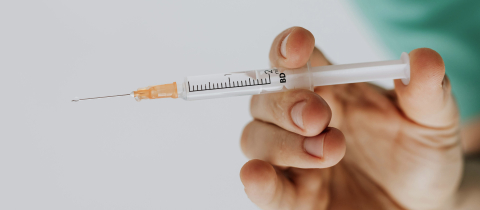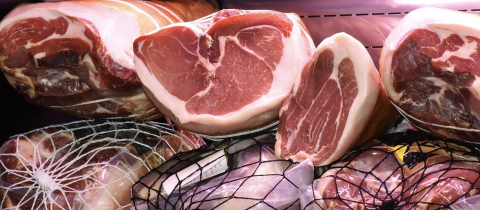I attended a seminar many years ago given by a Ph.D. student who had spent years working on a particular type of childhood cancer. During the question-and-answer period, I raised my hand. I wanted to know why it was that children even got cancer when most cancers require decades of mutation accumulation.
The student didn’t seem to understand my question, which I reformulated a couple of times before one of the professors in the audience turned to me and said, “It’s stochastic,” meaning it’s random, it can’t be predicted, and it’s just bad luck.
Let’s just say that I remained unsatisfied.
When adults get diagnosed with cancer, the question they often ask themselves is “why me?” But from a biological perspective, it’s not surprising. The way in which our cells divide requires so many moving parts that, once in a while, something is going to break down, leading to the uncontrolled cell growth characteristic of cancer. This breakdown takes decades. Yet, retinoblastoma, a tumour of the back of the eye that almost only affects children, usually gets diagnosed between the ages of one and two. How can cancer be a tortoise in adults but a hare in children?
The cancer ballet
Our bodies are made up of cells and these cells are not static. They will regularly duplicate their DNA content and split into two. This process, which is crucial to life, is very tightly regulated. It is called the cell cycle.
You can think of it as a wonderfully choreographed ballet involving hundreds of dancers—proteins, in the case of the cell cycle—and they all have a precise time to enter the stage, fulfill their role, and return behind the curtain. Day in, day out, proteins inside our cells perform Swan Lake over and over again, always hitting their mark. But sometimes, an important dancer is sick or is simply missing, and the choreography goes awry, more Black Swan than Swan Lake. Over time, more and more dancers get sick and the whole production gets out of control. The troupe starts invading the seating area, recruiting members of the audience for their insubordinate dance, and the massive, incoherent ballet pours out of the theatre and disrupts city life.
This is cancer.
Proteins in cancer misbehave or simply disappear because the genes that produce them have been mutated. Exactly when those mutations happen has a direct influence on when someone develops cancer. In 1971, Alfred Knudson proposed a hypothesis for how mutations and cancer were linked. It is known as the two-hit hypothesis.
For cancer to start, the prima ballerina has to be taken out of commission. But, of course, she has an understudy. We have two copies of most genes, one from our father and one from our mother. If one copy is rendered useless, we still have the other copy to make a functional protein. This is what Knudson zeroed in on. He hypothesized, quite correctly, that in cancer, a mutation arises that inactivates the first copy of that gene. Later, a second mutation needs to hit that other copy. When both the prima ballerina and her understudy have been quashed, the ballet starts to lose control. (Analogies inevitably break down. There is no one prima ballerina in our cells, but many prima ballerinas—proteins that play key roles—and different cancers will emerge from the mutation of different key ballerinas.)
Knudson used retinoblastoma to make his point about his two-hit hypothesis. The gene RB1 codes for the protein RB1, which acts as a necessary brake pedal in the cell cycle. When one copy of RB1 is mutated and then, later, the second copy, the RB1 protein can no longer play its role and cells start to divide out of control. At this stage, we see a benign tumour called a retinoma. If more mutations start to happen to other important proteins, the child will develop retinoblastoma, an actual cancer of the retina.
A key to understanding cancer is that sometimes that first hit does not happen during the patient’s lifetime: sometimes, they have already inherited it from one of their parents. They are thus predisposed to developing cancer, and if they do get cancer they will typically be diagnosed at a much earlier age. This is why a 60-year-old woman presenting to a doctor with breast cancer will be seen as “normal,” but a 25-year-old woman presenting with the same will arouse suspicions that she inherited an important mutation from a parent. This is the difference between sporadic cancers, where both hits need to happen during the patient’s lifetime and thus often take decades, and inherited cancers, where only one important hit needs to happen during the patient’s lifetime and thus cancer arises earlier.
This model explains why over half of all cancers affect people older than 70 and why young adults with cancer will often be sent for genetic testing and counselling, because the mutation they inherited from a parent could further spread throughout the family. But it doesn’t explain why children develop cancer in the first place.
That is because their tumours tend to be very different from adult cancers.
Fewer mutations, fusion genes, and epigenetic alterations
Even without an understanding of the underlying genetics, we can simply look at the cancers that typically affect adults and children and notice that they are not the same.
Leukemias, which affect white blood cells, make up about a third of all cancers in children, but they are 12th in frequency when looking at all age groups. The most common malignant brain tumour in children is medulloblastoma, which affects the back of the brain, but it is rarely found in adults. For glioblastoma, the opposite is true: common in adults but rare in children. Adults typically get diagnosed with breast, prostate, lung, or colorectal cancer. Children get afflicted by astrocytomas, leukemias, and osteosarcomas. Clearly, something different is happening here.
The first observation that comes out of the medical literature on pediatric cancers is that they have fewer mutations than adult tumours. In adults, the prima ballerina and her understudy are knocked out, and more and more ballet dancers subsequently stop doing their job. There is an accumulation of mutations in many genes, and that phenomenon both creates the cancer and helps it progress. In children, fewer mutations are needed to initiate cancer.
While all cancers feature mutations in important genes, the cancer-causing mutations that happen in children tend to be seen in genes that control progression through the cell cycle. The RB1 gene is a perfect example. When absent, the cell cycle keeps going without regulation, with cells dividing and dividing and turning into tumours.
We also see more fusion genes in pediatric cancers versus adult cancers. A fusion gene is when one half of a gene gets combined with one half of another gene, creating a new protein that did not exist before. It may not seem like much, but when the first gene has a very important role to play intermittently and the second gene acts as a license to do it all the time, we end up with an overactive gene that favours the uncontrolled division of cells. It’s like installing a rocket engine at the back of a car and snipping the brake line during the fitting. The part-car, part-rocket vehicle will cause havoc on the highway.
Finally, childhood cancers differ from adult cancers not just genetically but also epigenetically. Genes make proteins but genes do not make proteins continually. Just like the cell cycle is tightly regulated, so is the production of proteins through gene expression. That process is known as epigenetic regulation, where “epigenetic” means “on top of the gene.” There are ways in which the genes are rendered inaccessible or silent, and it involves things like methylation and histones, and the genes coding for those very things are often mutated in childhood cancers. It means that gene expression is not as restrained as it should normally be, which leads to tumours forming faster.
These answers are helpful but they are not enough for us to fully understand what distinguishes pediatric cancers from adult ones. All of these peculiarities seem to interact and when they happen in the wrong cell at the wrong time of development, cancer follows.
With all of this talk of mutations driving cancer, you may be wondering how these mutations happen in the first place. Here too our understanding is incomplete. We know that certain behaviours in adults increase the risk of them developing cancer later in life, like smoking cigarettes and being exposed to ultraviolet radiation (such as the one found in sunlight) without protection. But children are too young for their behaviour to cause cancer at a young age. Certain viruses clearly cause cancer in adults, such as HPV resulting in cervical and anal cancer (among others). In children, some viruses like the Epstein-Barr virus have been shown to play a role in the development and progression of cancer, but our knowledge here is fragmentary.
Much like in adults, roughly 10% of children with cancer are predisposed to it by inheriting a mutation from one of their parents. But as far as we know, everything else, as painful as it is to say, is stochastic. It is random, unpredictable, and just bad luck. Neither the parents nor the child is to blame.
Every year, 400,000 children and teenagers develop cancer worldwide. More research is definitely needed to further elucidate exactly why this happens and what we can do to help prevent it.
Take-home message:
- The types of cancers that usually affect children are different than the types of cancers common in adults
- Childhood cancers tend to require fewer mutations to develop; they often show fusion genes, in which parts of two different genes combine to create a protein that misbehaves; and they commonly show mutations in the molecules that regulate genes
- As in adults, about one in ten children with cancer will have inherited a mutation from a parent that predisposes them to developing a tumour







